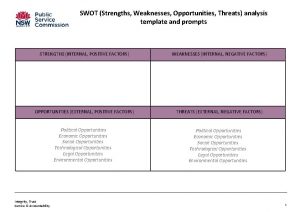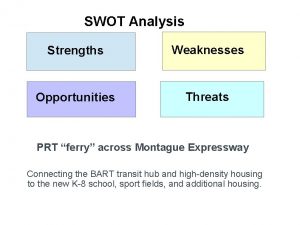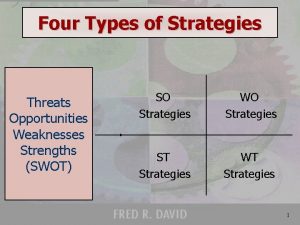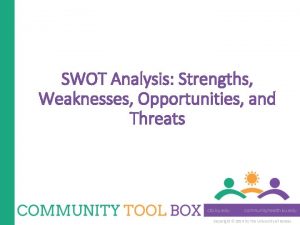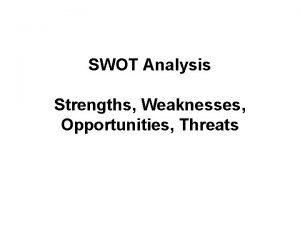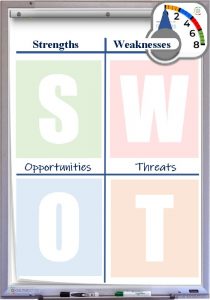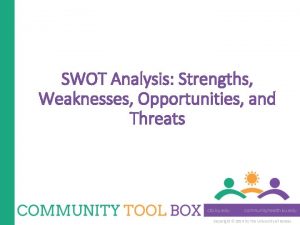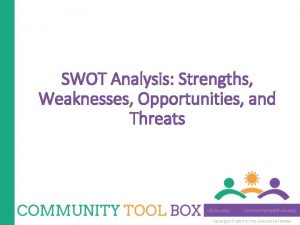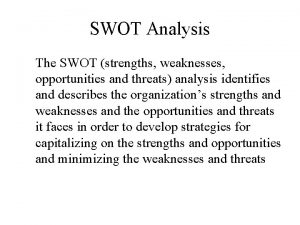SWOT Analysis Strengths Weaknesses Opportunities and Threats Copyright










- Slides: 10

SWOT Analysis: Strengths, Weaknesses, Opportunities, and Threats Copyright © 2014 by The University of Kansas

What is a SWOT analysis and why should you use one? A SWOT analysis guides you to identify the positives and negatives inside your organization (Strength & Weakness) and outside of it, in the external environment (Opportunity & Threat). Developing a full awareness of your situation can help with both strategic planning and decision -making. Copyright © 2014 by The University of Kansas

When do you use SWOT? • • Explore possibilities to problems. Make decisions for your initiative. Determine where change is possible. Adjust and refine plans mid-course. Copyright © 2014 by The University of Kansas

What are the elements of a SWOT analysis? Copyright © 2014 by The University of Kansas

What makes a logic model effective? • • Logically links activities and effects. Is visually engaging (simple, parsimonious) yet contains the appropriate degree of detail for the purpose (not too simple or too confusing). Provokes thought, triggers questions. Includes forces known to influence the desired outcomes. Copyright © 2014 by The University of Kansas

What are the benefits and limitations of logic modeling? Copyright © 2014 by The University of Kansas

Internal Factors: Strengths and Weaknesses (S, W) • • • Human resources Physical resources Financial Activities and processes Past experiences Copyright © 2014 by The University of Kansas

External Factors: Opportunities and Threats (O, T) • • Future trends The economy Funding sources Demographics The physical environment Legislation Local, national or international events Copyright © 2014 by The University of Kansas

How do you create a SWOT analysis? • Designate a leader or group facilitator. • Designate a recorder to back up the leader if your group is large. • Introduce the SWOT method and its purpose in your organization. • Let all participants introduce themselves. • Have each group designate a recorder; direct them to create a SWOT analysis. • Reconvene the group at the agreed-upon time to share results. • Discuss and record the results. • Prepare a written summary of the SWOT analysis to give to participants. Use it to: Identify the issues or problems you intend to change. Set or reaffirm goals. Create an action plan. Copyright © 2014 by The University of Kansas

How do you use your SWOT analysis? Use it to: • Identify the issues or problems you intend to change. • Set or reaffirm goals. • Create an action plan. Copyright © 2014 by The University of Kansas
 Strengths opportunities threats weaknesses
Strengths opportunities threats weaknesses Strengths opportunities threats weaknesses
Strengths opportunities threats weaknesses Advantages of content analysis
Advantages of content analysis Types of opportunities
Types of opportunities Opportunities and threats of a bakery
Opportunities and threats of a bakery Swot analysis of a teacher
Swot analysis of a teacher Swot analysis for english students
Swot analysis for english students List of opportunities and threats
List of opportunities and threats List of opportunities and threats of a student
List of opportunities and threats of a student Swot of johnson and johnson
Swot of johnson and johnson Marks and spencer strengths and weaknesses
Marks and spencer strengths and weaknesses
